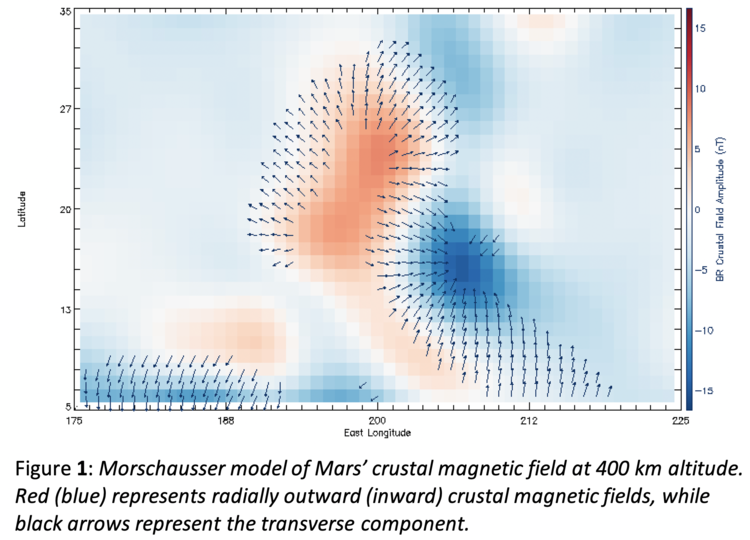MAVEN Observations of Mini-Magnetosphere Dynamics within the Dayside Ionosphere of Mars
- 1University of Michigan, Ann Arbor, Climatology and Space Sciences and Engineering, Ann Arbor, Michigan, United States of America (bowersch@umich.edu)
- 2NASA Goddard Space Flight Center, Greenbelt, Maryland, United States of America
- 3Department of Geophysics, Kyoto University, Kyoto, Japan
- 4Space Sciences Laboratory University of California, Berkeley, California, United States of America
At Mars, the conductive ionosphere and localized, crustal magnetic anomalies interact with the upstream solar wind creating a unique, hybrid magnetosphere. As the interplanetary magnetic field (IMF) lines encounter the planet, the nature of their interaction with the magnetosphere will vary depending on whether they encounter regions in which crustal anomalies are absent, primarily in the northern hemisphere, or regions of strong (100-1000 nT at the surface) crustal magnetic fields, primarily in the southern hemisphere. Around regions of weak crustal magnetic fields, the IMF first encounters the conducting ionosphere of Mars and drapes around the obstacle analogous to the dayside of planets without global intrinsic magnetosphere. Around regions of strong crustal fields, the magnetic anomalies protrude out into space and create a “mini-magnetospheric” interaction between the draped IMF and the crustal anomalies analogous to the dayside of planets with a global intrinsic dipole field. Previous studies at Mars using both the Mars Global Surveyor (MGS) and Mars Atmosphere and Volatile EvolutioN (MAVEN) observations have found evidence of complex dynamics within these mini-magnetospheres within the dayside ionosphere, including current sheets, and magnetic flux ropes. Both these phenomena play a role in plasma transport and acceleration within the ionosphere and are associated with magnetic reconnection, which implicates a variety of dynamic process in planetary magnetospheres.

In this study, we focus a single crustal anomaly region (CF1) in the northern Martian magnetosphere (~185°-215° longitude, ~5°-30° latitude (Figure 1)). Despite the magnetic moment of this anomaly being roughly 9 times weaker than those of strongest anomalies at Mars, it still shows evidence for dynamic interactions between the anomaly and the draped IMF. Here, we present analysis of current sheets and magnetic flux ropes found directly downstream from CF1 using magnetic field data taken by the magnetometer (MAG) instrument on board MAVEN. We also use data from the Solar Wind Electron Analyzer instrument to estimate magnetic topology, known as the topology score. This parameter distinguishes among 7 magnetic topologies and allows us to analyze the magnetic connectivity of the lobes of the current sheets and the likely formation mechanism of the flux ropes.
Limiting our search to regions where MAVEN was on the dayside sampling at low altitude (<1000 km) around this anomaly, we used a modified version of previously developed procedures to search MAVEN MAG data for the quick magnetic field rotations that define current sheet crossings. We have identified 15 current sheets in the regions surrounding CF1 within the dayside ionosphere of Mars. Of the 15 current sheets, we see examples of 3 magnetic topologies exhibited within the lobes (closed-dayside, open-dayside, and draped). This suggests the magnetic field lines that comprise the lobes of the current sheets may have a variety of sources on either side of the current sheet. For example, current sheets around CF1 may be formed at the interface between the draped IMF and crustal anomaly, between the crustal field lines themselves, or between multiple draped IMF field lines on top of the anomaly.
Magnetic flux ropes on the dayside of Mars are thought to have multiple formation mechanisms, some involving magnetic reconnection of a current sheet. We visually inspected MAG data for over 300 orbits to search for flux ropes near CF1 and applied Minimum Variance Analysis to identify these structures and determine their orientation. From these 300 orbits, we identified 10 magnetic flux ropes in the near-downstream region of CF1. These flux ropes exhibit the same 3 topology scores as those measured in current sheets. Previous studies have suggested the topology of a flux rope detected on the dayside of Mars indicates its likely formation mechanism. Flux ropes in our database suggest a variety of interesting processes occurring around CF1, including magnetic reconnection between the draped field and the transverse component of the magnetic anomaly.
The detection of current sheets and flux ropes with a variety of topologies near a single, weak crustal anomaly in the northern hemisphere suggests that “mini-magnetospheric” processes are not limited to regions of strong crustal fields found in the southern hemisphere. The properties of these current sheets and flux ropes, including their topology score, suggest a variety of interesting processes including magnetic reconnection with multiple sources of magnetic field lines on either side of the X-line. Furthermore, CF1 only protrudes out to low-altitudes (<350 km) during nominal solar wind conditions, which is slightly above where the atmosphere of Mars is collisional, suggesting ion-neutral collisions may play a role in these dynamics. Our identification of these processes at Mars will further our understanding of the dynamics that comprise the complex coupling between planetary magnetospheres and atmospheres, as well as their interaction with the solar wind.
How to cite: Bowers, C., Slavin, J., DiBracccio, G., Harada, Y., and Xu, S.: MAVEN Observations of Mini-Magnetosphere Dynamics within the Dayside Ionosphere of Mars, European Planetary Science Congress 2021, online, 13–24 Sep 2021, EPSC2021-305, https://doi.org/10.5194/epsc2021-305, 2021.

